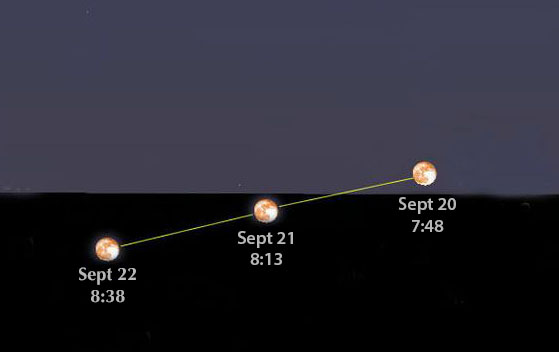Sky Report September 20 – September 26

In September the moon rises each night only 25 minutes later than the night before.
Autumn begins on Wednesday, September 22nd, precisely at 1:20 p.m. MDT. That’s the moment when the sun, in it’s apparent annual motion around the sky (the reflection of the earth’s motion around the sun) crosses the sky’s celestial equator. The celestial equator is the projection of the earth’s equator into space; during the summer the sun is north of it and during the winter south, and when it crosses the equator is the equinox. “Equinox” comes from Latin for “equal night” because on the equinox the nights are equal in length to the days. Following the autumn equinox the nights are longer than the days, as we well know, until the spring equinox. The cause of our seasons is the earth’s axial tilt of 23½°; if the earth weren’t tilted the sun’s path across the sky would be the same each day and we’d have no seasons.
The seasons are reversed in the Southern Hemisphere. As the sun becomes lower in our northern sky it becomes higher in theirs, as you would expect.
The equinox is also when the rate of change of the time of sunset (and sunrise) from one day to the next is at its greatest.
The full moon closest to the equinox is the Harvest Moon, and this year that falls on September 20th. Because the path the moon takes around the earth intersects the horizon at a shallow angle in the fall, the full moon rises at a similar time for several nights in a row, rather than much later each succeeding night, and its bright light helps farmers work their fields later in the evening; hence its name.
An understandable explanation of seasons and the Harvest Moon is in the Old Farmer’s Almanac (Google it).
Every planet has seasons, and their lengths depends on their distance from the sun and the time it takes them to complete one orbit (their year). Neptune is tilted 28° and its seasons each last over 40 years. In contrast, Mercury is tilted only 2° and has no meaningful seasons.
The planets are pretty much where they were last week. Brilliant Venus is low in the west for the hour and a half after sunset. Jupiter and Saturn are in the south; Jupiter is the brighter of the two and Saturn is to the right of Jupiter. Mercury and Mars are too close to the sun to see.
Under a grant from the Utah Governor’s Office of Economic Development and the Kane County Office of Tourism, Stellar Vista Observatory offers portable telescopes and tripod mounted binocular kits on loan for free to all residents of Kane County. Nothing beats a quality binocular or astronomical telescope to enhance enjoyment of the night sky! Visit https://stellarvistaobservatory.org/discover-the-night-sky/ or Kanab City Library for full details.
The Sky Report is presented as a public service by the Stellar Vista Observatory, a nonprofit organization based in Kanab, Utah, which provides opportunities for people to observe, appreciate, and comprehend our starry night sky. Additional information is at www.stellarvistaobservatory.org. Send questions and comments to John@StargazingAdventures.org.






Comments are closed.